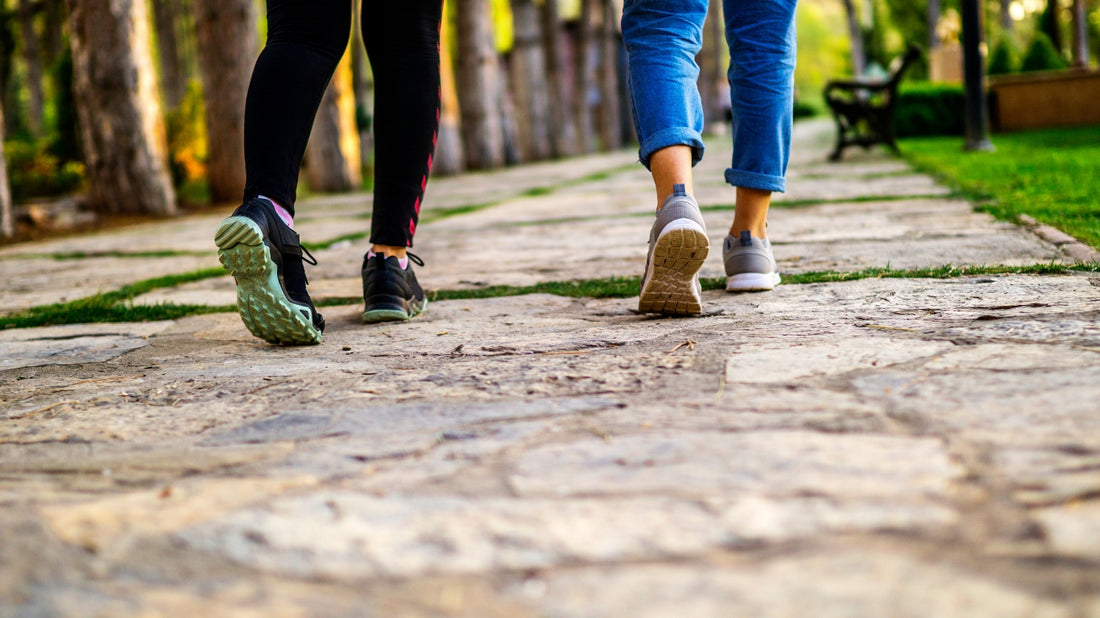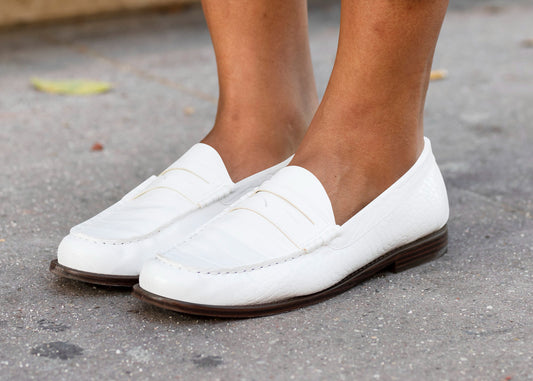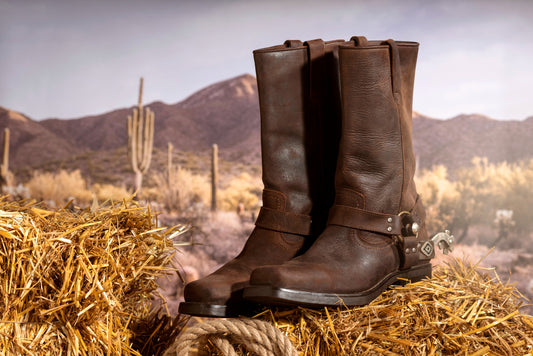How Long Do Walking Shoes Last - Replacing Shoe Guide

Do your running or walking shoes feel a bit off lately? If you're noticing that your favorite sneaker doesn't bend easily at the toe, or you're experiencing discomfort like plantar fasciitis, it might be a sign from your trusty brand footwear that it's time to replace them.
Just like any other item we use daily, shoes have a lifecycle, and recognizing when they are no longer serving their purpose is essential for maintaining foot health and comfort.
Join us as we explore the signs that indicate it's time to retire your old pair and learn when it is time to replace your shoes, ensuring your next step is always a comfortable one.
Factors that Affect the Lifespan of Walking Shoes
First off, let's talk about what makes running and walking shoes often wear out quicker than one might expect. The key is in the fitness regimen: during a vigorous workout session, shoes absorb a considerable amount of shock. This constant compression and release affect not just the insoles but also the overall structure of the shoe.
Over time, the materials lose their flexibility, leading to a diminished shoe's lifespan, making it imperative to choose shoes designed for the long run.
Material Quality
The quality of materials used in the construction of running and walking shoes plays a pivotal role in determining their durability. Shoes crafted from high-quality, resilient materials can withstand the rigors of daily wear and absorb shock more effectively, thereby extending their lifespan.
On the contrary, shoes made from inferior materials are likely to compress and wear out faster, necessitating frequent replacements.
Frequency of Use
How often you lace up your shoes for a run or a walk directly influences how long they last. Regular runners or walkers, putting their shoes through intense workout sessions several times a week, will notice a quicker degradation in their shoes' performance and comfort level.
This accelerated wear and tear mean those using their running and walking shoes often need to monitor their footwear's condition more closely and replace them more frequently.
Type of Surface Walked On
The surface on which you run or walk also impacts the longevity of your shoes. Hard surfaces, such as concrete and asphalt, can cause more rapid wear, especially in the outer sole, leading to a diminished ability to absorb shock effectively.
Conversely, softer surfaces, like grass or trails, tend to be gentler on shoes, potentially prolonging their usable life.
Read related article: How To Break In Running Shoes - 4 Different Ways You Can Try
Foot Pronation and Gait
Individuals' foot pronation and gait patterns can significantly affect the evenness of wear on their shoes. Overpronators or those with a distinct gait may find their shoes wearing down unevenly, impacting their shoes' overall effectiveness and lifespan.
It's important for such individuals to select shoes that cater specifically to their walking or running mechanics.
Overall Build Quality
Lastly, the general build quality of the shoe, encompassing the stitching, bonding materials, and design integrity, can determine how well a shoe stands up to the test of time and use.
Superior construction can resist the stress of repeated impact, maintaining the shoe's structure and support, whereas poorly constructed shoes may quickly succumb to the pressures of regular use.
Signs That Your Walking Shoes Need To Be Replaced
Sometimes, shoe owners are unaware of the gradual changes that occur in their walking shoes, expecting them to last indefinitely. However, the truth is starkly different.
The lifespan of walking shoes is significantly affected by several indicators that signal it's time for a replacement. Key among these indicators are changes to the shoe's midsole, the foam component responsible for providing arch support and shock absorption.
Over time, this foam can compress, especially towards the back near the heel, reducing the shoe's ability to cushion each step effectively.
Changes to the Sole
One clear sign that it's time to consider new walking shoes is when visible changes to the sole appear. The soles are designed to withstand constant contact with the ground, but they will wear down inevitably.
Uneven wear and tear, often a result of individual gait patterns, can lead to compromised shock absorption and stability. This unevenness can force the foot into an unnatural position, putting undue stress on the arch and leading to potential discomfort or injury.
Uneven Wear and Tear
Uneven wear and tear not only affect the sole's integrity but can also indicate deeper issues with the shoe's overall support structure. For instance, if the inside or outside of the heel wears down more quickly, it suggests that the shoes are no longer providing the necessary balance, leading to potential misalignment and discomfort.
This uneven wear can exacerbate issues for individuals with specific gait patterns, such as overpronation or supination, making timely replacement crucial for maintaining foot health.
Discomfort or Pain While Walking
Another unambiguous signal that your walking shoes need replacing is the emergence of discomfort or pain while walking. This discomfort often stems from the breakdown of the midsole foam, resulting in diminished support and shock absorption.
When the shoes can no longer cushion your steps effectively, it can lead to soreness in the feet, ankles, knees, and even the back. Ignoring these signs and continuing to use worn-out shoes can lead to more serious injuries over time.
Lack of Support or Cushioning
As walking shoes age, they may start to lose their inherent support and cushioning qualities, making every step less comfortable than the last. This deterioration significantly impacts the shoe's performance, as the midsole no longer provides the arch support necessary for a smooth, pain-free walking experience.
This loss of support can lead to fatigue quicker and increase the risk of foot and leg pain, emphasizing the need for periodic assessment and replacement of one's walking shoes.
Read related article: How Long Do Running Shoes Last?
Bad Odor or Visible Damage to the Shoe Material
Finally, a clear sign that your walking shoes are past their prime is the presence of bad odor or visible damage to the shoe material. Over time, shoes absorb sweat and moisture, leading to unpleasant odors that can be difficult to eliminate.
Furthermore, visible damage such as tears, holes, or separation of the shoe materials not only affects the aesthetic appeal but also the functionality and comfort of the shoes. These signs are unmistakable indicators that it's time for a new pair.
Check out Stone and Clark's Shoe Deodorizer Spray to keep your walking shoes smelling fresh and clean.
When Should You Replace Your Walking Shoes?
In general, walking shoes should be replaced every 3 to six months or 300 to 500 miles. The same goes for athletic shoes that are used for intense workouts several times a week. However, as mentioned earlier, several factors can accelerate the need for replacement, such as foot pronation and gait patterns, the surface being walked on, and overall build quality.
It's essential to pay attention to these signs and replace walking shoes when necessary to ensure optimal comfort, support, and injury prevention. Proactively replacing your walking shoes can also save you money in the long run, as worn-out shoes may lead to costly injuries and potential medical expenses.
Tips for Extending the Lifespan of Your Walking Shoes
As much as we want our shoes to last longer, wear and tear are inevitable. However, there are steps you can take to extend your walking shoes' lifespan and get the most out of them.
- Invest in High-Quality Walking Shoes: Spending a bit more upfront on shoes with superior materials and construction can significantly prolong their life, providing better long-term support and durability.
- Rotate Between Multiple Pairs of Shoes: Alternating shoes gives them time to air out and return to their natural shape, reducing wear and extending their usable life.
- Save Your Walking Shoes for Exercise Only: Limiting the use of your walking shoes to exercise sessions prevents unnecessary wear from everyday activities, keeping them in optimal condition.
- Clean and Store Your Walking Shoes Properly: Regularly cleaning your shoes to remove dirt and sweat, and storing them in a cool, dry place, helps prevent material degradation and odor buildup.
- Replace Insoles Regularly: Even high-quality shoes can benefit from new insoles, as replacing them can renew the shoe’s internal support and cushioning, enhancing comfort and extending the shoe’s lifespan.
- Use Water and Stain Repellent: Treating your walking shoes with a water and stain repellent spray can help protect them from the elements, reducing the chances of damage and prolonging their life.
Read related article: How To Buy Good Walking Shoes - Shoe Buying Guide
Closing Thoughts
Don't wear just any pair of shoes when it comes to running or walking for exercise. Considering how often you should replace your running shoes is crucial for maintaining comfort, support, and preventing injury. Aiming to get new shoes every three to six months is a good rule of thumb, especially if you're active regularly.
By investing in high-quality footwear and replacing them at the right intervals, you can ensure that your feet remain well-supported during every workout.
Also, consider these tips mentioned earlier to extend the life of your shoes, making each pair a worthwhile investment in your health and fitness routine.






